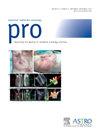Radiation Therapy for Graves’ Ophthalmopathy: When Is the Optimal Timing of Treatment and Evaluation
IF 3.5
3区 医学
Q2 ONCOLOGY
引用次数: 0
Abstract
Purpose
Despite the decades of using radiation therapy (RT) for Graves’ ophthalmopathy, the effects and optimal timing remain unclear. We retrospectively analyzed to evaluate the overall efficacy and response, predictive factors, and the effective timing of RT by assessing steroid requirement after RT in patients without prior surgery.
Methods and Materials
Between 2008 and 2022, we analyzed 74 patients with Graves’ ophthalmopathy who received RT to both orbits. Concurrent steroid therapy was administered to 51 patients. Symptoms were evaluated using a modified clinical activity score (CAS), defining responders as those with a ≥2 score improvement in CAS, diplopia, or a significant reduction in exophthalmos asymmetry. Common symptoms included eye swelling (81.1%), and conjunctival edema (81.1%). Diplopia observed in 48 patients (64.9%).
Results
Median follow-up was 44.5 months (range, 4.8-169.6). CAS significantly improved in the early-immediate phase, 1 month after RT (P < .001). However, diplopia showed significant improvement at a relatively late phase, 4 months after RT (P = .039). Patients treated with steroids concurrently showed a faster response compared to those without steroids. Initiating RT within 12 months of symptom onset resulted in a shorter duration of steroid use after RT compared with later initiation (65 vs 286 days, P = .011).
Conclusions
Our study suggests an evaluation period of at least 4 months after RT regardless of concurrent steroid treatment, recognizing the prolonged improvement timeline for diplopia. Additionally, for reducing steroid use after RT, our study suggests optimal timing of RT within 12 months of symptom onset.
巴塞杜氏眼病的放射治疗:何时是治疗和评估的最佳时机?
目的:尽管放疗治疗巴塞杜氏眼病已有几十年的历史,但其效果和最佳时机仍不明确。我们进行了回顾性分析,通过评估未接受过手术的患者放疗后对类固醇的需求,评估放疗的总体疗效和反应、预测因素以及有效时机:2008年至2022年间,我们分析了74例接受双眼眶放疗的巴塞杜氏眼病患者。51名患者同时接受了类固醇治疗。我们使用改良临床活动评分(CAS)对患者的症状进行了评估,并将CAS评分、复视或眼球外侧不对称程度显著降低且改善两分或两分以上者定义为应答者。常见症状包括眼睛肿胀(81.1%)和结膜水肿(81.1%)。48名患者(64.9%)出现复视:中位随访时间为 44.5 个月(4.8-169.6 个月)。CAS在放疗后一个月的早期明显改善(p结论:我们的研究表明,无论是否同时接受类固醇治疗,放疗后的评估期至少为四个月,因为复视的改善时间较长。此外,为了减少放疗后类固醇的使用,我们的研究建议放疗的最佳时间为症状出现后的 12 个月内。
本文章由计算机程序翻译,如有差异,请以英文原文为准。
求助全文
约1分钟内获得全文
求助全文
来源期刊

Practical Radiation Oncology
Medicine-Radiology, Nuclear Medicine and Imaging
CiteScore
5.20
自引率
6.10%
发文量
177
审稿时长
34 days
期刊介绍:
The overarching mission of Practical Radiation Oncology is to improve the quality of radiation oncology practice. PRO''s purpose is to document the state of current practice, providing background for those in training and continuing education for practitioners, through discussion and illustration of new techniques, evaluation of current practices, and publication of case reports. PRO strives to provide its readers content that emphasizes knowledge "with a purpose." The content of PRO includes:
Original articles focusing on patient safety, quality measurement, or quality improvement initiatives
Original articles focusing on imaging, contouring, target delineation, simulation, treatment planning, immobilization, organ motion, and other practical issues
ASTRO guidelines, position papers, and consensus statements
Essays that highlight enriching personal experiences in caring for cancer patients and their families.
 求助内容:
求助内容: 应助结果提醒方式:
应助结果提醒方式:


